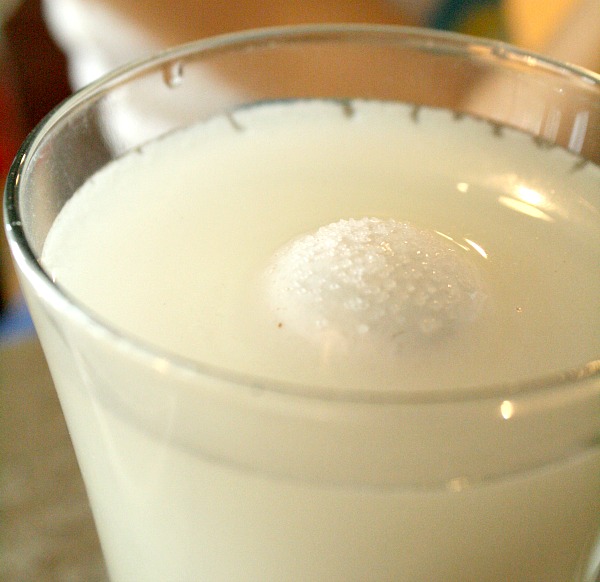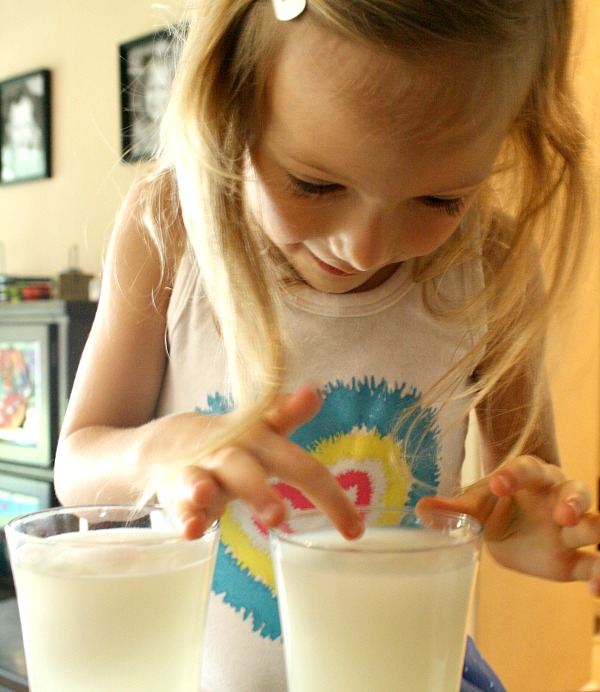We love to do simple science experiments! At home and in the classroom science experiments are a very meaningful way to get kids engaged and thinking about the world around them. This floating egg science experiment involves just a couple of everyday materials you probably already have on hand!
In the classroom the kids were always amazed to see this egg trick I found at Funology. It’s simple and quick, but there’s a lot of learning involved too. Lovey and I recently tried a variation of the traditional experiment. We were boiling eggs for breakfast, and Lovey noticed that the eggs in the pan sink to the bottom. I decided to set up this experiment so we can do a little learning before breakfast.

Materials for Floating Egg Science Experiment
- Two glasses 2/3 full of water
- Two containers of salt (Lovey measured 3/4 of a cup, but you could do the experiment with a bit less.)
- One raw egg
- One hard-boiled egg (Mark one egg so you can tell the difference.)
Predictions
Based on Lovey’s observation earlier that morning. We discussed what we thought might happen. She predicted that the hard-boiled egg would sink and turn the water hot. (We had cooled it by running cold water over it, but it was still warm.) She predicted that the raw egg would float and turn the water cold.
 Procedure
Procedure
First she dropped the raw egg into the water.
Then she dropped the hard-boiled egg into the water. Both of them sank to the bottom.
Then she slowly poured the salt into the glass with the raw egg. She didn’t think anything was going to happen.
But WOW was she surprised when that egg popped to the top!
Why? Adding salt changes the density of the water, so the egg floats to the top.
Then she added salt to the glass with the hard-boiled egg to see if it would float, too.
And it did!
After finishing the experiment, she wondered whether she could make the egg sink again. She poked at it a bit and had fun watching push its way back to the top each time.
After doing this activity she showed what she had learned in various ways. While cooking with my mother she mentioned they could add water to make things float in their pot. And while playing with pumpkins in the water table, she noted that they float even if there was no salt in the water. I see even more explorations with water density in our future!
Get a Full Week of Egg Theme Learning and Play
Save time and get right to the playful learning with our printable lesson plan sets. Each set includes over 30 playful learning activities related to the theme, and we’ve provided different versions for home preschool families and classroom teachers so all activities are geared directly toward your needs.
This set includes active hands-on learning ideas and the following printables:
1) Egg Beginning Sound Sorting Activity
2) Uppercase and Lowercase Egg Puzzles
3) 0-35 Egg Number Cards
4) 1-20 Number Basket Sorting Mats
5) Numbers and Sets Matching Puzzles (2 variations for differentiated instruction)
6) Oviparous Animals Emergent Reader (2 variations)
7) 4 Math Game Cubes
8) Egg Cards (for patterning, sorting, and ordering by size)
9) Oviparous and Non Oviparous Animal Sorting Activity
10)Oviparous animal word cards
Get Your Lesson Plans
Also available on Teachers Pay Teachers…
Home Preschool Egg Theme Lesson Plans
Preschool Classroom Egg Theme Lesson Plans
More Math and Science Activities with Fizz, Pop, Bang!
Fizz, Pop, Bang! Playful Science and Math Activities is designed to bring hands-on fun to math and science play. It’s full of engaging and powerful learning opportunities in math and science, shared through ideas that incorporate art, play, sensory learning and discovery, for a whole-brain approach.
It includes 40 educational projects and 20 printables including a set of build-your-own 3D shape blocks, engineering challenge cards and a range of math games.
Learn more about Fizz, Pop, Bang! or you can buy it now!
 Procedure
Procedure










PlaSmartToys
What a fun experiment. As you discovered, this is a great way to get children asking questions and taking what they’ve learned and applying their findings to other situations. Great job!
PlaSmarttoys.com
@PlaSmart
Anna@The Measured Mom
Your daughter must be so full of life – she has such beautiful smiles in your pictures! I love the look of amazement on her face. Thanks for linking up!
Shaunna Evans
She is! I don’t always do the best job of capturing her expressions…sometimes she’s also intensely focused. Thank you
Anna@The Measured Mom
Featuring on Monday!
Laughing Kids Learn
Thank you for linking up this idea to ‘Share It Saturday’. I look forward to featuring it this weekend.
Hopefully you will be able to link up more of your brilliant ideas.
Shaunna Evans
Thank you so much for featuring this post! I love linking up to Share It Saturday.
Julie
The expressions you captured on your daughter’s face say it all. What a great experiment! I would love it if you link up with Entertaining and Educational this Friday. – http://highhillhomeschool.blogspot.com
Megan Sheakoski
Great experiment! I need to try this with my kiddos!
Shaunna Evans
Thanks, Megan!
Natalie F
We love this experiment – we did a while back when we talked about Israel and The Dead Sea. So fun! Thanks for sharing with Afterschool!
Shaunna Evans
Great curriculum connection! I’ll have to remember that and try the experiment again then.
Jen aka The Mad House
This is such a cool experiment.
Shaunna Evans
Isn’t it neat? And so simple!
Jessica
Great simple science experiment! It looks like it was a hit. I loved how you incorporated a hypothesis based on what happened earlier.
Shaunna Evans
Thank you! I try to focus on discussions a lot when we are doing science and math activities. This was often a challenge for my kindergarten students in the classroom, so I try to give the kids a lot of practice discussing their ideas and observations.
Charity
Thanks for hosting! Now following from Scrappy Bag Lady
Annette W {This Simple Mom}
Eggs are great fun with science…and salt! We had fun with lemons this week!
Shaunna Evans
So many fun things to explore with lemons! I bet you had fun.
JDaniel4's Mom
What fun! I can almost hear her giggling as the egg pops back.
Shaunna Evans
Exactly! Giggles galore!